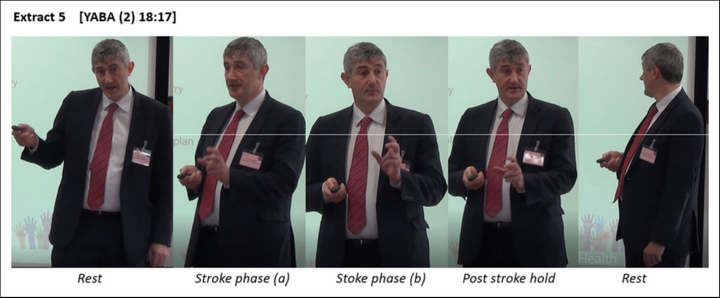These five subtle hand gestures can make a big impact on others.
When you are talking to others, you may notice that you flap or wave a hand to emphasize a point.
But does it matter if you remember to add a hand flourish? Turns out, they can make a big difference if you want to leave a memorable impression, especially at work.
In a 2019 study led by Jean S. Clarke of Emlyon Business School in Lyon, France, professional investors were asked to watch videos of an actor hired to pose as an entrepreneur pitching a new device that could treat sports injuries.
The investors were more interested in investing if they watched a video of the fictional entrepreneur using hand gestures to describe and symbolize his business ideas than when they watched the entrepreneur give the same pitch with his hands clasped in front of his body. Simple metaphoric gestures, like the actor widening his hands to show the potential market for the product, and “beat gestures” involving tapping his hands together to emphasize a point made a difference.
That’s because gestures reinforce what your words are trying to say.
“The gestures give more information, therefore you understand it better, but also gestures can help convey passion,” Clarke said. “When you use gestures, you can look more animated and you can look more passionate, and therefore, again, people might be more likely to buy into what you are saying.”
Clarke noted that in the study, investors would give more feedback such as “This guy’s really boring” when the entrepreneur did not use hand gestures. But “it wasn’t the guy who was boring,” she said, “it was just what was happening with the gesture.”
There is an important caveat, though: Your hand gestures can make you appear more excited and memorable, but Clarke and other communication experts noted that they are not enough on their own to persuade someone into agreeing with you.
“You can, to some extent, improve your body language, and that can help you be more persuasive, but you can’t trick people into agreeing with you if they really don’t agree,” Clarke said.
“I’m always hesitant to be like, ‘Crossing your fingers or doing this, that’ll kill you, or that’s great,’” said said Andres Lares, managing partner at Shapiro Negotiations Institute. “One thing generally on its own isn’t that impactful. It’s more about continuity and consistency of the message. Being consistent with what you’re saying with the body language, together that’s the most impactful.”
That being said, hand gestures are an important persuasive tool. Here are the hand gestures communications experts say can help you stand out and make your words more memorable when you are talking or speaking in public:
1. Holding Your Fingers In A Precision Grip

If you want to try incorporating just one hand gesture into your conversation, Clarke said the “precision grip” or “the ring” is one of the easiest to incorporate. It’s one she and other researchers analyzed in a separate study on common hand gestures that entrepreneurs use in a pitch to investors.

In this gesture, you bring your thumb and index or middle finger closer together to touch or almost touch. “It’s a way of pinching down to an idea,” Clarke said, that signal to audience that “This is a key part of what I’m saying. This is where we need to be paying attention.”
2. Holding Up A Number To Correspond With What You Are Saying

Holding up numbers while you are speaking about those numbers is a simple yet effective way to reinforce the consistency of your message and makes it more memorable.
“You are saying three and you are showing three,” said Lares, for example. This makes others focus more, because they anticipate they are going to get more cues, he said. “It makes it a little less likely that they will tune out.”
Particularly when meetings are on Zoom or other video, “our brain tends to make more of the little things that we can see,” Lares said, which is why these gestures can be an especially powerful way to support your message when speaking remotely.
3. Holding Your Hand Over Your Heart

Touching a hand over your heart while speaking about something sensitive or emotional for you also helps to reinforce the consistency of your message, Lares said.
“On its own, [it’s] not necessarily a massively impactful thing, but touching your heart while you say … ‘This is really important to me,’ it further conveys that,” he said.
4. Moving Both Hands Up And Down As If A Scale

When you comparing between two options, holding both hands palms up and moving them up and down as if you are weighing them can help your conversation partner understand the gravity of your decision better.
“Showing that while you are saying ‘It was a really tough decision,’” he said, helps makes the story you are telling more vividly memorable.
5. Holding Your Hands Palms Up

Lares noted that holding your palms up while talking can convey a positive and a disarming sentiment. “Closed hands or closed fists, less so,” he said.
Body language expert Vanessa Van Edwards analyzed some of the most-viewed TED Talks and major speeches, and synthesized them into 20 hand gestures she recommends people to follow. Holding up one’s palms was one of them.
As she put it, “When your hands are at a 45-degree angle with the palms facing up, you are showing openness and honesty. It’s like you are saying that you are laying it all out on the table.”
Hand gestures are powerful, but they cannot replace language.
Although hand gestures can help you, the wrong ones can work against you, too.
Using your hands to fidget with your outfit and your appearance is a no-no, for example. Repeatedly adjusting your clothes, or your hair, or touching your face in one spot a lot while speaking can suggest you are uncomfortable with what you are saying, Clarke said.
“They convey emotional insecurity on some level. Those types of gestures aren’t really useful,” she said.
But don’t blow one hand gesture out of proportion, good or bad. Lares gave the example of someone crossing their arms: On its own, it’s possible they’re doing it just because they’re cold in the office. But if it is combined with the person angling themselves away and not maintaining eye contact, then it signals “Yeah, whatever we are talking about, you don’t care about. I’ve pissed you off, you’re frustrated,” he said. “On its own, crossed arms? I wouldn’t read too much into that.”
What you are gesturing ultimately is not going to cancel out or be an equal replacement for what you are saying.
“Especially with body language, people think that it’s so powerful. And it is powerful, but it can’t stand in place of words,” Clarke said. “Words are also really, really important
Credit: Source link